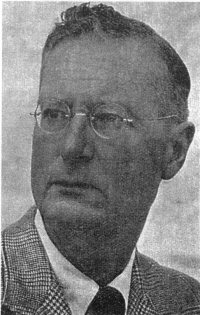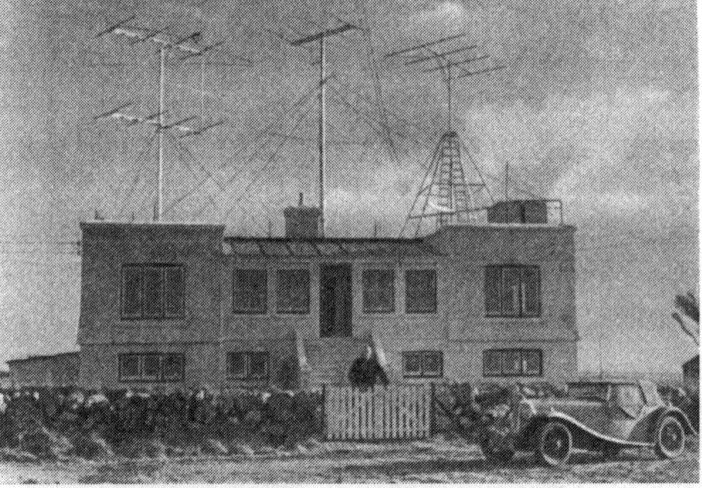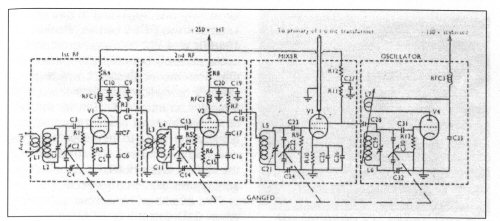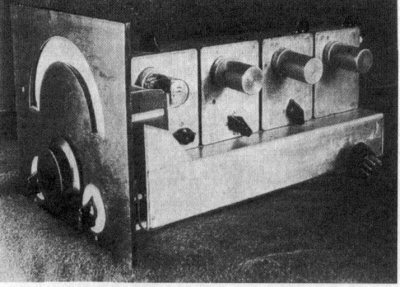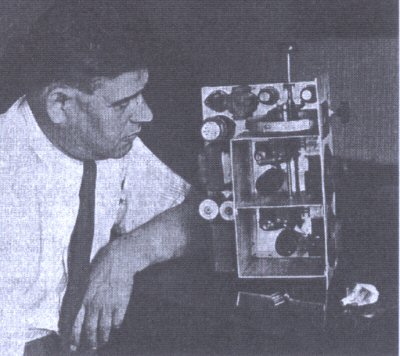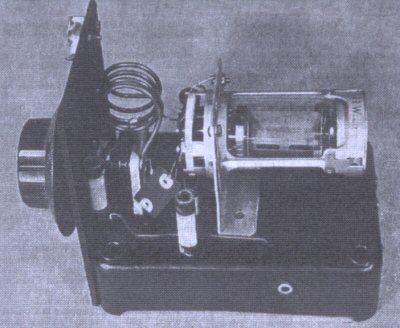

home > archive > the history of 6m > 50 years of 50 MHz part 5
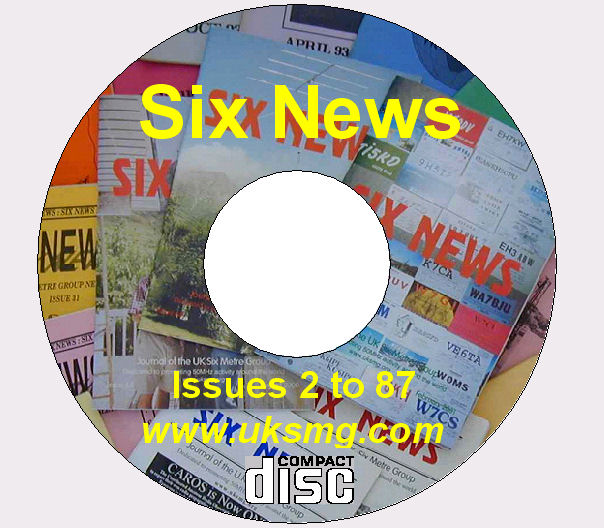
Thanks to all of our authors since 1982!
50 Years of 50 MHz Part 5 - Ken Willis, G8VR |
||
|
I am especially appreciative of having been given this award because of my very long friendship with the late Ken Ellis G5KW, which started in a time before many current UKSMG members were born. By the time Ken's key became silent, we had lived through years that saw remarkable changes in life-style and incredible technological developments, far beyond anything we would ever have thought possible. These were years when to be a radio amateur was something rather special, and our simple attempts to operate at very short wavelengths were particularly exciting. Recalling some of them through my articles has brought back many memories and given me much pleasure. But please always remember, I am simply an archivist, not a creative writer. I dig into the past by reading old magazines, journals and reports of all kinds, anything relevant that I can lay my hands on, occasionally mentioning my own activities all those long years ago. Already my researches have found that some of my earlier articles need correction as a new fact emerges which impacts upon another. I am also very much aware that there must soon come a point at which readers will feel that they have heard enough from me about the ‘old days', so I will heed the words of an American friend who would comment: “ History, we don't need” when someone tended to dwell too long on a past incident which he preferred not to hear discussed! So have no fear that I have set my cap at winning the G5KW Award next time around. It was never my intention to bore you all to death. G5BY One of the early VHF ‘greats' was Hilton O'Heffernan G5BY, who probably did more than anyone this side of the Atlantic to open up the possibilities of communicating at frequencies above 50 MHz.
In his regular ‘Five Metres' column in the magazine Short Wave News for July 1947, the writer ‘AJ Devon' (a pen-name for the editor Austin Forsyth, G6FO) described a visit to Bolt Tail saying that : “The site was a magnificent one with clear views in all directions, and 19 acres of headland available for the erection of aerials” . Not only was this site a VHF operator's paradise, the station itself was very spacious - a complete house in fact, fitted out with everything necessary for serious VHF propagation experimentation. The photograph below gives some idea of the size of the station and shows various antenna arrays located on the flat roof.
With these facilities, high up on a cliff-top looking southwards over the sea, one can understand how G5BY was to become an international figure among operators using the five and six metre bands. But the location of his station was only one reason for the results he obtained. An accomplished engineer, he designed and built all his own equipment, with everything finished to a very high standard. An example is the 50 - 58 MHz receive converter pictured, which represented state of the art in 1946. In an article describing the converter he commented: “Full scale drawings were made and re-drawn until I was satisfied with the layout achieved. During construction not a single alteration – either electrical or mechanical — became necessary, so the considerable time spent on the initial design proved to have been really worth while” . He was known to work very quickly, so one might guess that he had access to some machine tools. Possibly he sub-contracted some equipment to be built to his specification, but as I will mention again later, on one occasion he stayed up overnight to build a transmitter from scratch to be ready for events planned for the following day. In comparing the circuit of the G5BY converter with that of the simple pre-war two-valve transceiver shown on page 28 in ‘Six News' issue 72, one begins to appreciate how equipment for the five and six metre bands had improved in the UK by 1947, no doubt aided by developments in the technology and the availability of valves and components required for war - the latter often finding their way on to the surplus market at very affordable prices. Early super-regenerative receivers were by now giving way to front-end VHF converters (one or more RF stages, mixer and tunable local oscillator) typically feeding into an HF-band receiver as the intermediate frequency amplifier. G5BY, though, used a home-brew dedicated 1.6 MHz IF strip, ahead of which he placed a variety of converters covering all the VHF bands in which he was interested (later 70 MHz and 144 MHz later claimed his attention).
At this time many of us including, according to the records, one ‘SWL Listener Bower' (later G3COJ of the UK Six Metre Group) were using surplus RF27 units developed by scientists at the revered Telecommunications Research Establishment, Malvern, for a radio navigation system known as ‘Gee'. Produced in large numbers for RAF Bomber Command, and after the war priced at a pound or two (old currency) in the junk shops, these comprised a complete three-valve VHF converter, with RF amplifier, mixer and local oscillator, all stages ‘gang' tuned. Being designed for operation in the 65-85 MHz range, only the coils had to be changed for operation on the 58 or 50 MHz bands. But some interesting ‘straight' receivers were also being built, a good example being one by Hodinin, OK2MV, who incidentally was the first OK to work England on 58 MHz in June 1947, with G5BY at the other end (who else?). The transmitter used by OK2MV for this CW contact was mite less sophisticated, as the picture shows, but by now crystal- controlled transmitters like that pictured in ‘Six News' 71 were more common. Directional high gain arrays (yagis) were replacing wire antennas, and the scene was set for some real DX contacts on frequencies above 50 MHz.
In this part of the spectrum television restrictions still limited UK amateurs to their 58 MHz band, but at least they could listen on the six-metre band for signals from amateurs lucky enough to live in countries that had a 50 MHz allocation. Fortunately, in America the television service on a much higher frequency channel continued to expand rapidly, allowing six-metre activity there to increase accordingly to the eventual great benefit to amateurs world-wide. But until the first special permits for 50 MHz operation were issued, UK amateurs could not transmit between 30 and 58 MHz. They knew very well that an MUF high enough for propagation on 58 MHz would occur very infrequently, if at all. Even catching days when the MUF was up was not as easy as it is today; this was long before the inauguration of a service providing daily ‘figures', based on the Sun's radio emissions as an indicator of high F2 ionisation.
But none of this deterred G5BY, who for hours on end monitored both 50 and 58 MHz relentlessly while keeping a watching brief on 28 MHz for possible cross-band contacts.
Cycle 18 As autumn approached in 1946, solar activity was beginning to rise from a low-point two years earlier. Peaking in 1948, it was not to be an outstanding cycle, certainly not when compared with the more recent Cycle 22 which gifted Britain's newly-licensed six-metre operators with so much DX. But for the first time, amateurs in several parts of the world were ready, in the sense that they now had equipment capable of probing the highest levels of MUF that could reasonably be expected to occur. The events of November 24 th 1946, when G6DH heard W1HDQ on six metres and answered him on ten metres, have received much publicity. I described them in some detail in issue 67 of our journal (November 2000) under the title “A Bit of History”, but I now know that G6DH was not the first to hear the USA station. For some months, G5BY had been following regular listening schedules on 50 MHz while across the pond, Ed Tilton W1HDQ, VHF editor of QST, was running a series of tests involving transmissions on 50 MHz for five minutes in each quarter-hour, meanwhile listening for replies on 28 MHz and 58 MHz. During one of these tests, at 11.16 UTC on the morning of November 24 th 1946, W1BEQ in Connecticut telephoned Ed to say that he was in contact on ten metres with G5BY who said he was hearing W1HDQ on Six. A two-way was immediately attempted with G5BY transmitting on 58 MHz, but not surprisingly the MUF was far too low for contact to be made. Since G5BY was copying Ed's telephony at over S9, it is not clear why he did not immediately go to 28 MHz to make a cross-band contact. But at the same time, G6DH was receiving a carrier but could only positively identify the callsign when Ed resorted to CW. As conditions started to improve, G6DH made his memorable cross-band contact at 11.19, giving a report of S7. G5BY then followed him, and continued to hear the American until 1225 UTC, an opening of 68 minutes. At G6DH however, the signal was lost at noon; an indication, maybe, of the advantage of G5BY's westerly location (remember G5KW's expedition to the Scillies?). Earlier this same day, at 10.17 UTC, G5BY had been listening to what was later identified as auto-transmission from a ship in American waters signing WEDI on 52.9 MHz, the signal reaching well over S9 at times and continuing until 1044. There was naturally a friendly rivalry between G6DH and G5BY, both professional radio engineers, but there is little doubt that G5BY had by far the better station, plus much more free time to monitor the frequencies. Lacking the ability to access the F2 layer, in 1947, progress in the UK on the 58 MHz band was measured either by the distance between stations or by countries worked (mostly via sporadic-E). The country list in 1947 comprised France, Italy, Holland, North Africa, Switzerland, Sweden, Denmark, Belgium, Czechoslovakia, Malta and Gibraltar - that's eleven, not counting UK prefixes. Needless to say, G5BY had at one time or another worked all of them. On six metres however, in those countries having 50 MHz allocations, operators were by now accustomed to working over much greater distances (for instance, within the continental USA and Africa), while the CE1AH - J9AAO contact mentioned in the last issue is an example of the wide-world capability of the ‘Magic Band' under the right conditions. On October 3 rd 1947 G5BY completed a cross-band contact with ZS1P in Cape Town, the South African transmitting on 50 MHz and Hilton on 28 MHz, though he also tried on 58 MHz without success. This was the first ever six-metre DX worked from South Africa. By the end of 1947, G5BY had made cross-band contacts with nearly 100 USA/Canadian six metre stations in 13 states and four Canadian provinces. By the end of 1947, armed with his special permit, he was competing with USA stations for WAS having worked no fewer than 24 states.
Special permits As a result of pressure being brought to bear following the G6DH/W1HDQ contact a year earlier, limited-period special permits for operation on 50 MHz, were issued to a few selected G stations in 1947, coming into force at midnight on November 4 th . Obviously G5BY was one of those who received a permit. Perfectionist that he was, he decided he needed a dedicated transmitter for the band so he stayed up overnight on November 4th/5 th to build one, completing it at 4.00 am. The aim was to be ready for any possible band opening to the USA later the same morning. In the event, the first two-way 50 MHz contact between the USA and the UK occurred on the morning of November 5 th 1947, between G6DH and W1HDQ, with several other permit holders following up. Within a few days the excitement was quelled by an ionospheric disturbances which all but wiped out communication until about November 15 th , but during November conditions improved sufficiently for several Gs to work Ken Ellis MD5KW, who himself had a field day working into ZS and VQ2PL - the latter hearing a W8 in Cincinnati. The ‘G6DH events' in 1946 and1947 received a lot of publicity. Almost unnoticed in the records, I found a mention of PA0UN who apparently was licensed for six metres and on 28 th October 1947 worked four east-coast USA stations and heard a Canadian. So G6DH was not the first European station to bridge the Atlantic on 50 MHz. On November 22 nd , F8OL made the first transatlantic six-metre contact from France, and at the time there were nine French and two Algerian stations holding special permits. And of course in the USA inter-state contacts alone were clocking up huge distances. Here in the UK we were very much down the pecking order and destined to remain there until Cycle 21.
UKSMG Six News issue 74, August 2002 |
the early history of 6m
six in fifty-seven
down memory lane
6m history
historical 6m
rigs
6m history by G6DH
50yrs of 50megs
pt1
50yrs of 50megs pt2
50yrs of 50megs pt3
50yrs of 50megs pt4
